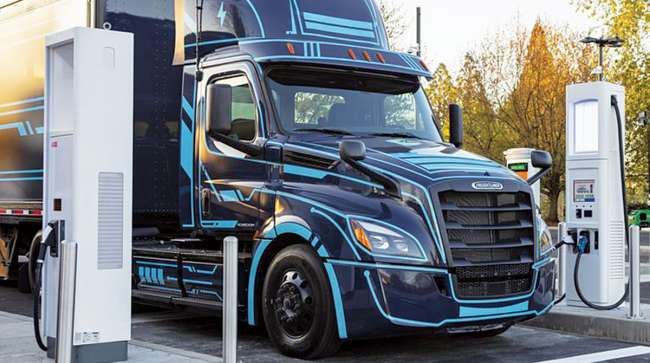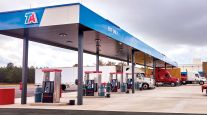Staff Reporter
DOE Funds Plans for EV Charging, Hydrogen Fueling on Freight Corridors

[Stay on top of transportation news: Get TTNews in your inbox.]
Projects that aim to accelerate adoption of electric and fuel cell-powered medium- and heavy-duty trucks along freight corridors in 23 states are earmarked to receive $7.4 million in funding from the U.S. Department of Energy.
“A clean transportation sector requires vast investments across the entire industry, including to decarbonize the trucks that move our goods and building more charging ports to get those trucks from coast to coast,” said Energy Secretary Jennifer Granholm in a Feb. 15 announcement.
Projects will focus on electrification plans for essential and heavily trafficked domestic freight corridors serving California, the Southwest, Midwest, Eastern seaboard and Northeast.
“The projects, administered by DOE’s Vehicle Technologies Office and Hydrogen and Fuel Cell Technologies Office, will advance the president’s decarbonization goals by accelerating the deployment of medium- and heavy-duty EV charging and refueling infrastructure to reduce emissions from freight corridors and the depots, ports and other facilities those corridors service,” DOE stated.
The agency noted that the projects reinforce DOE’s Justice40 Initiative, established by an executive order signed by President Joe Biden which stipulated that 40% of the overall advantages of some federal investments (including clean energy) benefit disadvantaged communities.

Granholm
DOE noted that the allocations will help improve air quality in underserved areas around Chicago, Houston, Los Angeles, New York, Oakland, Salt Lake City and San Francisco.
The largest grants ($1.25 million each) target three planning efforts:
- The Interstate 95 freight corridor from Georgia to New Jersey: Pasadena, Calif.-based nonprofit CALSTART will plan the project, focused on infrastructure for zero-emission medium- and heavy trucks.
- An I-80 corridor for Illinois, Indiana and Ohio: Cummins Inc. will develop a two-phase plan for both EV charging and hydrogen fueling for medium-and heavy trucks that aims to enable 30% of fleets to use EV and fuel cell technologies by 2035.
- The I-10 corridor from Los Angeles to Houston: The Gas Technology Institute, an Illinois nonprofit, will devise a plan for a flexible hydrogen fueling and heavy-duty freight truck network that will feature adaptable methodology for future hydrogen corridors throughout the country.
Receiving the next-highest amount at $1.2 million was Utah State University for a multimodal corridor electrification plan in the greater Salt Lake City region. The goal is to establish an action plan, supported by community, state and industry stakeholders, to improve air quality in regional underserved communities most impacted by high-density medium- and heavy-duty traffic.
National Grid will get $1 million to predict demand for EV charging at traffic stops on freight corridors across Connecticut, Maine, Massachusetts, New Hampshire, New Jersey, New York, Pennsylvania, Rhode Island and Vermont. The information will be used as a blueprint to deploy large-scale, least-cost commercial EV charging. The company delivers electricity, natural gas and green energy to 20 million customers through its networks in New York and Massachusetts.
Targeting three truck market segments in the San Francisco Bay Area, the Rocky Mountain Institute in nearby Boulder, Colo., was awarded $750,000 to create an EV charging infrastructure roadmap supporting full electrification for drayage, regional haul and longhaul trucks.
The smallest grant at $688,850 went to Los Angeles Cleantech Incubator to formulate a charging network that integrates freight movement along Southern California’s I-710 freeway. The project will recommend infrastructure solutions at industrial facilities and commercial zones along freight arteries feeding into I-710. Another focus will determine how private sector fleets can establish an integrated network using existing industrial/commercial real estate assets that benefit municipalities and communities.
Want more news? Listen to today's daily briefing below or go here for more info:




